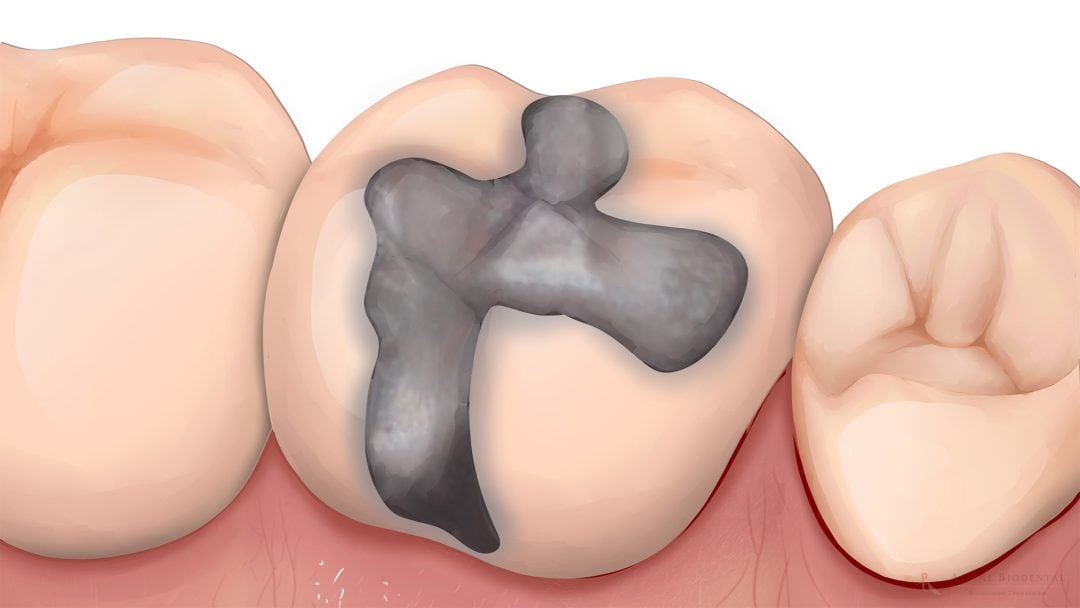Amalgam Filling Removal

More and more people want to have their amalgam fillings removed – whether for health reasons, because of the silvery appearance or for other reasons.
The dentist should take protective measures when removing the amalgam so as not to endanger the patient, themselves or the dental staff.
The removal of amalgam fillings is an essential part of biological dentistry and is becoming a significant issue for more and more patients.
In this article you will find all the important information about amalgam removal so that you can decide whether or not to have your silvery filling removed.
Amalgam Fillings and Health
Amalgam is an alloy that consists of 50% mercury, the most toxic non-radioactive element in the periodic table.
When installed in the teeth, amalgam fillings constantly release small amounts of mercury through mechanical abrasion, corrosion and the release of mercury-containing vapors during chewing. These mercury molecules are then absorbed into the body via mucous membranes, ingestion and the lungs and deposited in organs, fatty tissue and nerve tracts.
This results in toxicological and immunological effects, which can have a noticeable impact on the health of those affected.
Amalgam fillings were placed in the mouth for many decades to repair broken teeth. Even today, amalgam is still used in many dental practices around the world because its ease of processing and durability are highly valued.
To find out more about amalgam, please read the article Amalgam fillings.
Removing Amalgam - Safe Procedure
When removing an amalgam filling, the drilling process naturally results in a drastically increased amount of mercury vapors and amalgam particles, from which both the patient and the practice staff must be effectively protected.
At Alpine BioDental, this is achieved through a whole series of closely coordinated measures that ensure the best possible protection for everyone involved:
1. Correct removal technique:
The amalgam filling is removed completely in one piece without having to drill into the metal. The formation of amalgam chips, toxic vapors and the final exposure to mercury can thus be reduced to a small fraction. The correct choice of instruments, a great deal of experience on the part of the therapist and a careful, precise approach are prerequisites. Although the technique requires more time, it offers great safety for the patient, dentist and practice staff.
2. CleanUp suction device:
A special suction device, which is placed tightly around the respective tooth with a silicone sleeve, absorbs practically all particles and vapors directly where they are produced when the tooth is drilled out. Care should be taken to use a central suction machine with high performance.
3. Gold mask
Even if the correct technique and the CleanUp suction device already ensure that virtually no vapors are released that could be inhaled by the patient or the treatment team, the airways of everyone in the room (patient, dentist, assistant) are protected with a gold-coated mask.
Gold has a high binding affinity to mercury. This means that the last mercury molecules not captured by the other measures remain trapped in the gold coating of the mask. Alternatively, FFP3 masks can also be used, but these have a poorer filtration value.
4. IQ-Air air filter:
As an additional safety measure, a high-performance HEPA room air filter, which is able to remove particles down to a size of 0.003 micrometers from the air, also runs during amalgam removal. The suction device is positioned above the patient in such a way that an air suction is created away from the patient’s mouth and the treatment field in the direction of the air filter.
5. Insertion with activated charcoal or chlorella:
Once all amalgam residue has been completely removed from the tooth, the cavity is filled with chlorella algae or activated charcoal to remove any remaining mercury residue on the surface.
bind. After removing the inlay, the cavity is disinfected with ozone. The tooth can then be restored and rebuilt with a high-quality resin filling or a ceramic inlay or partial crown.
6. Latex-free rubber dam:
A rubber dam is an elastic cloth that is stretched in front of the patient’s mouth using a frame and isolates individual teeth from the rest of the oral cavity. The rubber dam provides a tight, mechanical barrier for all amalgam particles, whereby the protection against mercury vapors is limited. The ability of mercury vapors to penetrate the rubber dam depends on the material, the thickness and the material expansion when stretched over the frame. A latex-free silicone with a thickness of at least 0.5 mm, which is used carefully without much stretching, is therefore preferable. Rubber dam can also influence the effective, dynamic suction of the CleanUp suction cup and, due to its roughness, offers a pronounced adhesion surface for amalgam particles. Furthermore, rubber dam can severely impair visibility and the space for precise work, which makes measure 1 very difficult. All these points lead to so many particles sticking to the rubber dam that it appears silvery and the emission of mercury vapors (the vapors are particularly harmful to health) increases significantly. As rubber dams offer both advantages and disadvantages when removing amalgam, their use is always decided on an individual basis.
Symptoms after Amalgam Removal
To avoid symptoms and side effects after amalgam removal, safety precautions and protective measures are important, as careless removal can result in large amounts of mercury being absorbed into the body and making it ill.
Whether acute or chronic symptoms occur after removal depends largely on the amount of mercury ingested and the patient’s state of health. Weakened, older people with pre-existing conditions are less able to compensate for exposure than a healthy and young person.
If the amalgam fillings are removed under protection, the risk of acute amalgam poisoning with symptoms is very low.
Amalgam Leftovers in the Jaw
Unfortunately, it is often the case that patients with previous amalgam fillings also have amalgam residues in their jaw. The complete cleaning of the jawbone is also part of the complete amalgam restoration and should not be neglected.
Amalgam residues enter the tissue in different ways:
- When amalgam fillings are removed incorrectly, small splinters can be propelled into the tissue at high speed.
- When teeth with amalgam fillings are removed, fragments of the amalgam can fall into the open tooth socket and remain there.
- During tooth extraction, parts of the adjacent amalgam filling can also break off and enter the open wound. This happens when the extraction forceps or the lever rubs and presses against the amalgam.
Amalgam residues in the jaw can pose a massive health risk and should be removed carefully.
Healthy Alternative to Amalgam Fillings
After the safe and harmless removal of the amalgam filling, it must be replaced with a high-quality and healthy alternative. Replacing the amalgam filling is important to protect and stabilize the tooth. In most cases, leaving a tooth defect in place is not an alternative.
Healthy alternatives to amalgam fillings are ceramic fillings, plastic fillings or ceramic crowns. The choice should depend on the size of the defect and stabilize the tooth as well as possible.
Ceramic Filling
Ceramic fillings are the ideal choice for small to medium-sized tooth defects in terms of longevity and biology. They are made individually and accurately in the dental laboratory and can precisely restore the shape of the tooth.
It is also important to use the best possible cement or composite when fixing the ceramic filling.
Plastic Filling
Plastic fillings are a good and inexpensive compromise to ceramic fillings. They can only be considered if the tooth defect is rather small. Above a certain size, it is difficult to restore the tooth shape and tooth contacts, so ceramic fillings should be preferred.
A high-quality, healthy product should also be chosen for the material.
Ceramic Crown
The ceramic crown is the best choice for unstable teeth with large tooth defects. The tooth is encircled by the crown and optimally stabilized.
They are produced by experienced dental technicians in the dental laboratory, taking into account the correct anatomical shape, accuracy of fit and aesthetics.
Removing Amalgam
Once the amalgam has been removed under protection, the body can be gradually detoxified. However, as long as amalgam is present in the oral cavity, detoxification is not possible and can be dangerous because toxins can be redistributed.
There are various ways of removing amalgam.
The most effective detoxification can be carried out with the help of chelating agents such as DMPS, DMSA or EDTA. However, natural substances such as alpha-lipoic acid or glutathione also have good detoxifying properties.
In general, the removal of amalgam or mercury should always be supervised and monitored by an experienced doctor or alternative practitioner.
Dr. Artur Hein
The removal of amalgam should be done with safe protective measures to avoid poisoning due to exposure. We will be happy to advise you.

Frequently asked Questions about Amalgam Removal
Many patients carry amalgam fillings around with them for a long time and do not know whether they should decide for or against amalgam removal. Here are some frequently asked questions on the subject.
It is up to each patient to decide whether to remove the amalgam or leave it in place. There are definite health benefits to removing amalgam. The probability of developing chronic complaints is higher with amalgam fillings in the mouth.
The fact that the material is very durable speaks in favor of leaving the amalgam fillings in place. In fact, there are few materials that can match the longevity of amalgam. The enormous durability is also a disadvantage because exposure to mercury can occur over many decades.
If amalgam has been removed without protection, it is possible that the body has absorbed a large amount of mercury. It is therefore advisable to consult a doctor who specializes in detoxifying the body. They will be able to determine the extent to which the body has been poisoned and take appropriate measures.
Yes, many doctors recommend having amalgam removed before a planned pregnancy. The reason for this is the high placental permeability of mercury – i.e. the transfer of mercury to the embryo via the placenta.
No, it should be avoided during pregnancy, as despite the highest protective measures, exposure can never be 100% ruled out.
No, breastfeeding mothers should also avoid amalgam removal. The mercury can easily pass into the breast milk and affect the baby.
Yes, as long as there is amalgam in the teeth or in the tissue, heavy metal elimination is not possible.
Metallic fragments are best diagnosed by X-ray, with a CBCT 3D X-ray or CT (computer tomography) of the head.
Amalgam is classified as hazardous special waste and is collected accordingly in special containers and handed over to specialized disposal companies.
The waste water from all dental chairs must be filtered by an amalgam separator. The filtered water then enters the waste water pipes.
Every time a tooth is treated, it can suffer trauma and possibly die. In our dental practice, we take various precautions to ensure that the tooth remains calm, even in the case of deep caries or amalgam fillings.
Further information
The information listed contains relevant topics for a better understanding.